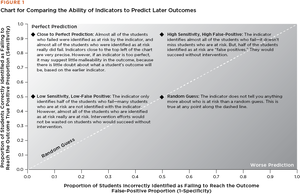1. Which middle grade metrics predict ninth-grade failure? Based on those metrics, which middle grade students are at risk of failing their ninth-grade classes, and which are likely to pass their classes when they get to high school?
2. Which middle grade metrics predict earning high grades (3.0 or higher) in high school? Based on those metrics, which middle grade students have little chance of earning high grades in high school and which students are likely to do so?
3. Which middle school metrics predict reaching ACT’s college-readiness benchmarks? Based on those metrics, which middle grade students are at risk of missing the benchmarks when they get to high school and which students are likely to meet them?
4. How does students’ performance on key indicators change during the middle grades, and what are the implications for high school success?
Key Findings
- Only those students who leave eighth grade with GPAs of at least 3.0 have a moderate chance of earning a 3.0 GPA in high school—the threshold for being considered college-bound.
- Whether students are “ready” for high school depends not only on their academic performance in the middle grades but also on the context that they enter into in ninth grade. Students with the same academic record in middle school also have different high school outcomes depending on which high school they attend.
- Strategies aimed at attendance improvement could likely have as much or more of a payoff for high school and college graduation as efforts aimed at improving test scores because test scores are hard to move and do not show much variability throughout middle and high school. Meanwhile, attendance shows considerably more variation and middle school attendance is much more predictive of passing high school classes than test scores.
Click below to view a 90-second episode of GO FIGURE, with Marisa de la Torre explaining Figure 2 of this research (April 9, 2024).
Click below to view a 90-second episode of GO FIGURE, with Elaine Allensworth explaining Figure 7 of this research (February 28, 2024).





